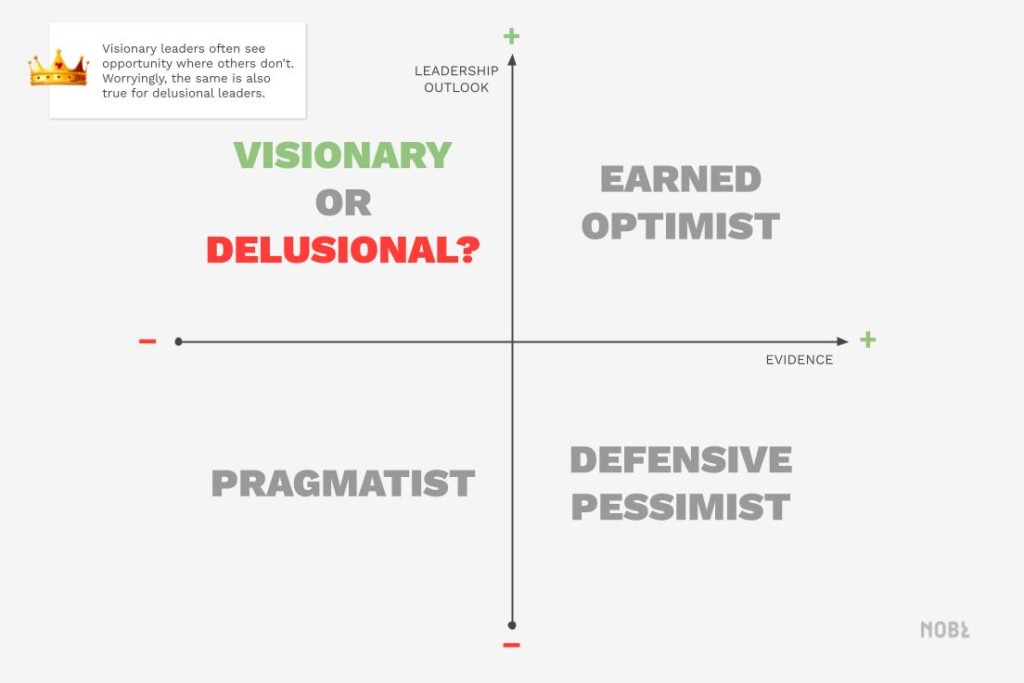We’ve all read the headlines or heard the rumblings: a leader once hailed as a luminary, pulled off their pedestal on account of a toxic workplace or epic business failure. It’s easy to blame these downfalls on delusional leadership or even narcissism (though it’s worth noting narcissism is actually a diagnosed personality disorder). The tricky thing is, the line between a visionary leader and a delusional leader is actually quite thin—visionary leaders see opportunities where others don’t. They have the ability to inspire optimism and rally teams behind a shared purpose, which is why we love and celebrate them.
Unfortunately, delusional leaders also see opportunities where others don’t, but for a different reason: they either don’t exist, or the work required to achieve them is unreasonable. When faced with a delusional leader, it can be easy to get sucked into the promise of their vision. After all, if they’ve got a team working under them, they’ve already had at least some success in selling their ideas. And in the face of uncertainty, teams do need leaders who can cast a vision of a future that may still seem out of reach. So where do you draw the line?

As psychologist Daniel Goleman writes, “Visionary leaders articulate where a group is going, but not how it will get there–setting people free to innovate, experiment, take calculated risks.” That sense of freedom and autonomy is imperative. A leader’s ability to understand the needs of their team and marry those with business objectives is critical, and requires a strong degree of emotional intelligence. It also means focusing on what makes a vision possible: the hard work of other people, combined with a healthy understanding of reality.
Rather than aiming to be the next great visionary leader, work towards becoming an earned optimist: someone who can balance their vivid imagination and positivity with realism and evidence. Keep in mind that you likely need the support of your team to achieve your vision, so lean in to empathic and inclusive practices:
- Take stock of your own leadership style. Build in practices for regular reflection on the impact of your actions and decisions. If you don’t have a good pulse on the impact of your leadership, whether good or bad, ask for feedback from your peers or direct reports. If people are reluctant to share feedback with you, it’s likely a sign that you haven’t created trust and psychological safety within the organization—but don’t let that stop you from asking! Try an anonymous survey or a leadership retrospective.
- Show up the way you want to be received. Research on emotional intelligence in leaders demonstrates that the mood of a CEO has a direct impact on the moods of others across the organization. It’s almost contagious. This isn’t to say that leaders should feign optimism or put on a “game face.” Rather, it’s to emphasize the need to create balance in your life so that you can show up authentically, and with empathy for the experience of others. For instance, if you slept poorly and didn’t have time to drink coffee, but know you need caffeine to be energized and friendly in the mornings, maybe reschedule that 9 AM meeting.
- Listen to your team. Ask for input on big decisions, share learnings regularly, and make yourself accessible. Be aware of how the decisions you make will impact others within the organization, and create inclusive pathways for contributions from team members. Keep in mind that you’ve hired people into their roles for a reason! If an expert on your team has a point of view to share, then it’s worth listening to, and taking action on, their suggestions.
- Emphasize a culture of learning. A well-articulated and grandiose vision may seem like the best way to galvanize team members and stakeholders alike, but small wins can go a long way. Even if the long-term vision is communicated clearly, teams need concrete goals that demonstrate progress in the short term, and help everyone to learn and evolve. Keep in mind that there’s a difference between introspection and reflection: you need to actually look back and evaluate the wins and losses.
If you find yourself on the other side of the table, sensing that you might be working for a delusional leader, consider:
- Does the leader accept feedback?
- Do they revise their ideas and plans based on actual evidence?
- Do they acknowledge the work required to achieve their grand ambitions?
If the answer is no to any or all of the above, it may be time to look for the exits.








The Evolutionary Edge
Every Link Ever from Our Newsletter
Why Self-Organizing is So Hard
Welcome to the Era of the Empowered Employee
The Power of “What If?” and “Why Not?”
An Adaptive Approach to the Strategic Planning Process
Why Culture/Market Fit Is More Important than Product/Market Fit
Group Decision Making Model: How to Make Better Decisions as a Team